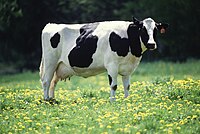
Photo from wikipedia
Abstract This research was undertaken with an aim to compare the pH, volatile fatty acid (VFA) profile, and ammonia concentration of ruminal fluid samples from pre- and postweaning dairy calves… Click to show full abstract
Abstract This research was undertaken with an aim to compare the pH, volatile fatty acid (VFA) profile, and ammonia concentration of ruminal fluid samples from pre- and postweaning dairy calves that were obtained through rumenocentesis (RC) and an oral stomach tube (ST) as well as to monitor the health-related complications of sampling techniques. During the first 84 days of life, 40 Polish Holstein–Friesian calves were grouped by dam parity (equal numbers of calves born to primiparous and multiparous cows) and assigned randomly to two treatment diets: concentrate, which comprised starter feed without oat hay (C; n = 20), and concentrate with forage, which comprised starter feed with 10% oat hay (CF; n = 20). The higher value of ruminal fluid pH was noted in the ST compared to the RC method. The average difference in pH between methods was 0.33 in the whole experimental period, and that difference was not affected by the treatment diet. We noted higher concentrations of ruminal ammonia; total VFAs; and molar concentrations of acetate, propionate, n-butyrate, isobutyrate, n-valerate, and isovalerate for the RC, compared with the ST method. Minor complications were recorded after ruminal fluid sampling via RC in three 8-week-old calves. Differences in ruminal fluid pH and fermentation parameters suggested that a comparison of rumen parameters sampled with different methods might be unreliable and should be avoided. Moreover, given its minimal impact on animal health, RC can be recommended for ruminal fluid sampling from dairy calves.
Journal Title: Livestock Science
Year Published: 2019
Link to full text (if available)
Share on Social Media: Sign Up to like & get
recommendations!